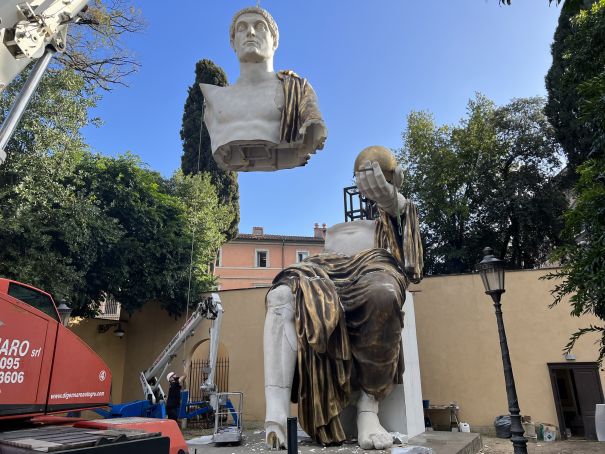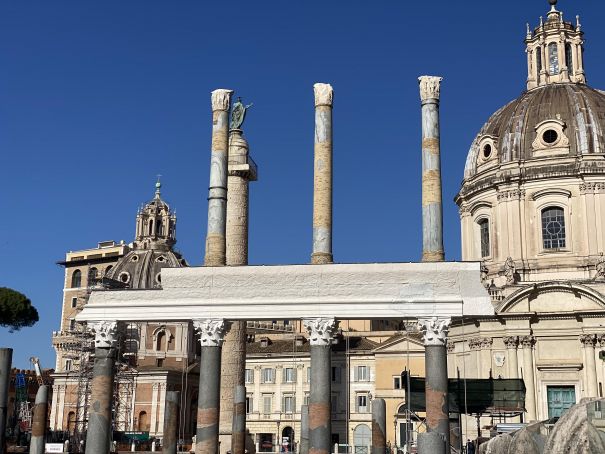Reconstructing Rome's Ancient Past
Rome unveils a series of projects that offer a glimpse of ancient glory.
Rome's recent historic re-enactments for its annual birthday - celebrated on 21 April in an annual tradition called Natale di Roma - attracted record numbers of participants.
Viral videos of the costumed parade commemorating the legendary founding of the city by Romulus in 753 BC suggest just how often the world thinks about the Roman empire.
Since the start of this year Rome has unveiled several major restoration projects, all of which made international headlines, in a move that brings the ancient past back to life.
Rome celebrates its 2,777th birthday today with a grand parade through the Eternal City #NatalediRoma pic.twitter.com/QXjqaRrd6E— Wanted in Rome (@wantedinrome) April 21, 2024
In early February the city presented a towering modern-day reconstruction of the Colossus of Constantine, recreated using 3D modelling technology, at the Capitoline Museums.
The 13-metre-high statue is a replica of the fourth-century Colossus which once stood in the apse of the Basilica of Maxentius in the Roman Forum.
Constantine, also known as Constantine the Great, ruled from 306 to 337 AD and was the first Roman emperor to convert to Christianity.
The reconstructed statue of the seated emperor, wearing a gilded tunic and holding a sceptre and orb, is the work of the Fundación Factum Arte company and was displayed in Milan last year as part of the Recycling Beauty exhibition.
The original Colossus of Constantine, made from marble and gilded bronze, was pillaged and broken before being rediscovered during excavations at the Basilica of Maxentius in the 15th century.
Rome inaugurates a 13-metre high replica of the ancient Colossus of Constantine. pic.twitter.com/1gkow07uaB— Wanted in Rome (@wantedinrome) February 6, 2024
The remaining marble fragments were moved to the courtyard of the Palazzo dei Conservatori in the Capitoline Museums in 1471 as part of the donation by Pope Sixtus IV of ancient Roman pieces to the world's first public museum.
The reconstruction of the Colossus was carried out with the contribution of the Prada Foundation and the Capitoline Museums, under the supervision of Rome archaeological superintendent Claudio Parisi Presicce.
Experts digitally scanned the remaining fragments from the original statue - including the head, right arm, right hand, right knee, right shin, a calf fragment, the right and left feet, the wrist and a chest fragment - using the high-resolution data to create 3D models of each piece.

The statue was then reconstructed using resin and polyurethane, together with marble powder, gold leaf and plaster, built around an internal aluminium frame.
The imposing replica of the Colosso di Costantino can be seen for free at Villa Caffarelli, part of the Capitoline Museums complex, until the end of next year.
Basilica Ulpia
Just a few minutes away from the Campidoglio, the landscape of Trajan’s Forum has changed dramatically in recent months.
A major restoration project to reconstruct part of the Basilica Ulpia, once the largest basilica in Rome, is now almost complete.
An architrave and a second tier of three columns in green cipollino marble have been added to the ruins using anastylosis, a restoration process which incorporates the original architectural elements to the greatest degree possible.
For the past century the three cipollino marble columns had been positioned erroneously elsewhere in Trajan's Forum until being restored to their rightful place, along the outer perimeter of the basilica's first nave.
Rome rebuilds part of the ancient Basilica Ulpia in Trajan's Forum, adding a second tier of columns and architrave to the ruins of the second-century basilica, once the largest in the city. https://t.co/M6RbRZYXjC pic.twitter.com/SQnqH074Dw— Wanted in Rome (@wantedinrome) April 8, 2024
Towering at a height of 23 metres, the partially reconstructed monument adds a whole new dimension to the ancient site, granting visitors a sense of the vast scale of the building which was once dedicated to the administration of justice and commerce.
Built by the architect Apollodorus of Damascus at the behest of the Emperor Trajan between 106 and 113 AD, the Basilica Ulpia collapsed in the mediaeval era, its ruins pillaged for construction material, before being excavated in the early 19th century and 1930s.
In contrast to the fanfare that heralded the reconstructed statue of Constantine, the city has been decidedly low-key in promoting its ambitious project in Trajan’s Forum, despite the enormity of the initiative and its permanent nature.

This is due to the fact that the patron of the ambitious restoration feat is a Uzbekistan-born oligarch who has been on the EU sanction list since March 2022 after Russia invaded Ukraine.
Seven years earlier, in 2015, metals tycoon Alisher Usmanov made a €1.5 million donation to fund the project, during the administration of former Rome mayor Ignazio Marino.
A giant Roman emperor and a new-look Basilica Ulpia are not the only new historical attractions that Rome has to offer.
Forma Urbis Museum
At the start of this year, the city opened a new museum and archaeological park in a forgotten corner of the Caelian Hill, against the backdrop of the Colosseum.
The Museo della Forma Urbis houses the remaining fragments of the Forma Urbis Romae, a giant marble map of ancient Rome engraved between 203 and 211 AD during the reign of Emperor Septimius Severus.
Visitors to Rome's new Forma Urbis Museum on the Caelian Hill can walk across a glass floor with fragments of a massive marble map of the city engraved in the early third century by order of Emperor Septimius Severus. pic.twitter.com/3h89t8JeaW— Wanted in Rome (@wantedinrome) January 11, 2024
The map, which originally measured 18 by 13 metres, was mounted inside the Temple of Peace before being destroyed during the Middle Ages when the marble was used as building materials or for making lime.
The Forma Urbis Museum allows visitors to fully enjoy the ancient marble map – not seen by the public for a century – with the original fragments placed under a glass floor which is superimposed with Giovanni Battista Nolli's 1748 Pianta Grande map of Rome.
Dancing on water. Rome inaugurates a new reflective pool at the Baths of Caracalla with a ballet set to Gershwin's Rhapsody in Blue. pic.twitter.com/tAnP2BefqQ— Wanted in Rome (@wantedinrome) April 13, 2024
Other recent projects include the installation of a large reflective pool at the Baths of Caracalla, which in addition to reflecting the majestic ruins will host cultural events, in what is being billed as a return of water to the ancient site after 1,500 years.
Meanwhile the city is currently fine-tuning plans to create a New Archaeological Walk linking Rome's ancient landmarks with new walkways, cycle paths and viewing terraces for a more pleasant and accessible visitor experience.
By Andy Devane





















